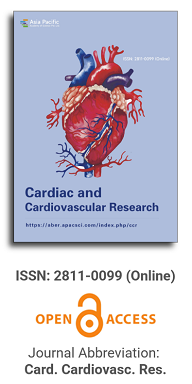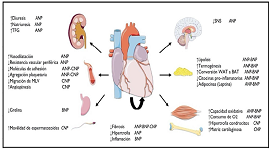
Asia Pacific Academy of Science Pte. Ltd. (APACSCI) specializes in international journal publishing. APACSCI adopts the open access publishing model and provides an important communication bridge for academic groups whose interest fields include engineering, technology, medicine, computer, mathematics, agriculture and forestry, and environment.

In recent years, cardiovascular disease research has deepened its focus on the advancements of multiple factors, revealing their profound impact on disease mechanisms and treatment outcomes.
Issue release: 31 December 2020
Testosterone is the main androgen in human body and has many important effects on cardiovascular system Testosterone deficiency is common in patients with cardiovascular diseases. Many data suggest that low serum testosterone level is related to cardiovascular diseases such as coronary heart disease, heart failure and arrhythmiahowever, the mechanism involved is not completely clearin recent years, the research on testosterone and cardiovascular diseases has attracted much attention. This paper summarizes the pathogenesis and influence of testosterone related cardiovascular diseases.
Issue release: 31 December 2020
Objective: To explore the relationship between extreme temperature and death from cardiovascular and cerebrovascular diseases in Chongqing, a “furnace city”, and its time regularity. Methods the death data of cardiovascular and cerebrovascular diseases, meteorological and environmental protection data from 2011 to 2013 in Chongqing were collected. The confounding factors such as air pollution, long-term and short-term trends were controlled. The distributed lag nonlinear model (dlnm) was used to analyze the lag effect and cumulative effect of extreme temperature on the death of cardiovascular and cerebrovascular diseases. Results for cerebrovascular disease death, the effect of high temperature was the greatest on the same day (rr= 166, 95% CI: 119–233) for 2 days; the influence of low temperature lags 4 days and lasts for 12 days. The maximum RR value appears on the 6th day (lag 6) and is 122 (95% CI: 106–141). For ischemic heart disease deaths, the effect of high temperature was greatest on the same day (rr= 188, 95% CI: 112–315) for 7 days; the influence of low temperature lags behind for 1 D and lasts for 27 D. The maximum RR value appears on the second day (lag 2) and is 205 (95% CI: 132–320). The cumulative risk of extreme high temperature (34 ℃) on death from cerebrovascular disease and ischemic heart disease was 208 (95% CI: 149–290) and 263 (95% CI: 127~542), and the cumulative effects of extreme low temperature (2 ℃) on them were 461 (95% CI: 185–115) and 120 (95% CI: 372–463). Conclusion the lag effect of extreme high temperature and low temperature on the death of the two diseases is different; the cumulative effect of extreme low temperature is higher than that of extreme high temperature, especially on the death of ischemic heart disease.
Issue release: 31 December 2020
In order to realize the classification and recognition of anterior myocardial infarction, inferior myocardial infarction, anterior septal myocardial infarction and normal ECG signals, this study takes the clinical database as the experimental data source, extracts the training set and test set data for training and testing the network model, optimizes the traditional neural network, and designs a new network algorithm: multi-resolution residual network. The multi-resolution residual network is visually compared with the traditional network to evaluate the recognition effect of the model. The test set accuracy of multi-resolution residual network is 91.8%, which is higher than that of classical neural network. The algorithm in this study can assist doctors in the diagnosis of myocardial infarction diseases, and has certain clinical significance.
Issue release: 31 December 2020
The World Health Organization has identified noncommunicable diseases (NCDs) as one of the greatest challenges of this century, accounting for 71% of deaths worldwide. Smoking is considered one of the main modifiable risk factors affecting NCDs. There is ample evidence linking smoking to cardiovascular disease, particularly ischemic heart disease. The 2016 European Society of Cardiology Cardiovascular Prevention Guidelines establish smoking cessation as a class I, level of evidence A recommendation. The effect of nicotine generates a strong addiction that triggers a withdrawal syndrome when attempting to quit smoking. Therefore, it is necessary to be familiar with the strategies for the treatment of tobacco addiction, which include: minimal intervention, cognitive-behavioral resources and pharmacological treatment such as nicotine replacement therapy, bupropion and varenicline. At present, there is insufficient scientific evidence to recommend electronic devices.
Issue release: 31 December 2020
Circulating particles (extracellular vesicles) have the function of transmitting information between cells in biological processes such as vascular regulation, inflammation, coagulation, cell proliferation and apoptosis. It contains complex and diverse components, which are closely related to the occurrence and development of cardiovascular diseases. In the future, circulating particles (extracellular vesicles) can be used as clinical markers to reflect coagulation function, inflammatory reaction, tissue and organ damage, or as clinical treatment targets to regulate vascular homeostasis, correct coagulation, improve internal environment, and protect tissue and organ function, which has important research significance. In this paper, we summarize the relevant research progress of circulating particles (extracellular vesicles) in the field of cardiovascular surgery, and discuss the role of circulating particles (extracellular vesicles) in the process of related diseases, as well as its research and application prospects in the diagnosis and treatment of related diseases.

Prof. Prakash Deedwania
University of California,
San Francisco, United States





 Open Access
Open Access